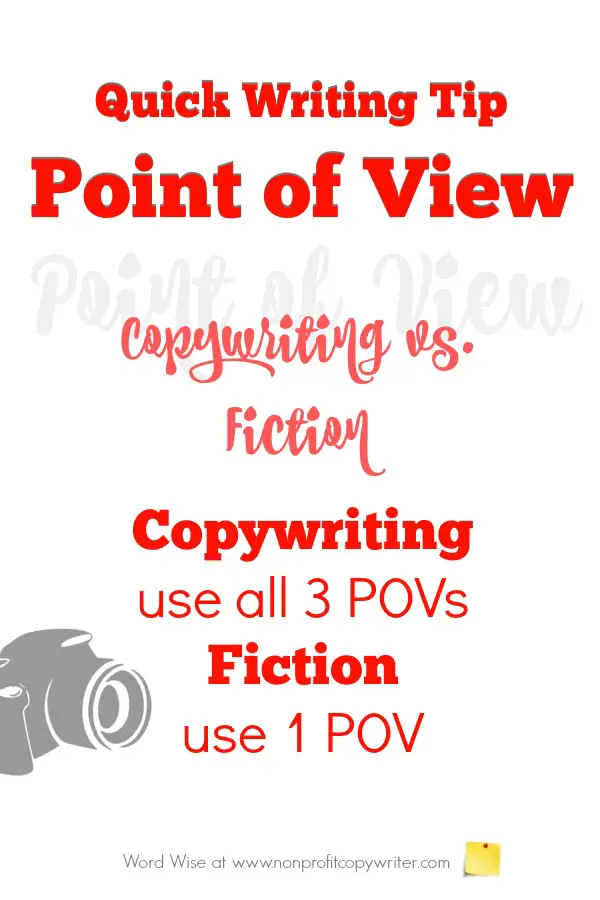Save Time: Get 5 Simple Writing Tips
you can put to use in 10 minutes
Point of View Explained for Copywriters and Content Writers
Award-winning writer Kathy Widenhouse has helped hundreds of nonprofits and writers produce successful content , with 750K+ views for her writing tutorials. She is the author of 9 books. See more of Kathy’s content here.
Updated 6.17.25
Point of View (POV) is the position you take as a writer while you narrate your content. It’s your lens, like a camera.
You explain the events or information from your view (first
person), directly to another individual (second person), or as an observer (third
person.)
How to Identify Three Points of View
Write from a POV by paying attention to the pronouns you use.
First person POV: personal experience
Write about experiences in your own voice using I/me, we/us, my/mine, our/ours.
“I want to understand POV as I write copy and content.”
Second person POV: interaction
Write by addressing the reader in a conversation, using you/your/yours or you understood.
“Make sure you understand POV as you write copy and content.”
Third person POV: observation
Write about experiences as an observer who is outside looking in, using he/she/it, his/hers/its, they/them/their.
“She wanted to understand POV as she wrote copy and content.”
Copywriting Tips for Using Point of View
When to Use Which POV?
- First person is used in both fiction and nonfiction.
- Second person is frequent in nonfiction – especially copywriting – but rare in fiction.
- Third person is the most common POV in fiction.
Use All 3 POVs in Copywriting - in the Same Piece
Copywriting and content writing are a conversation, not a lecture. That’s why a combination of all 3 POVs, with a special emphasis on first and second person POVs, work best.
Here's an example using just third person.
Writing with proper POV is a common problem (third person). Writers use third person and don’t know why they struggle to make their copywriting conversational (third person). A large percentage of new writers face this challenge (third person).
Try this instead, using all three POVs:
When I first started copywriting, I had to learn POV basics (first person). Writers use third person and don’t understand how to make copywriting conversational (third person). Is it a problem for you, too? (second person).
Use One POV for Fiction - and Stick to It
In copywriting and content writing, it’s natural to switch back and forth between point of view, particularly first and second person. Not so with fiction. When you write fiction, pick one POV and stick to it – most often first person or third person. This one-POV-rule applies to writing stories in your content.
Here’s an example:
I wish I could say this doesn’t happen often (First person). Writers switch between POV and don’t know they’re doing so (Third person). Is it a problem for you? (Second person).
Try this instead:
“I wish I could say this doesn’t happen often,” said Jane, the writing coach. She went on to explain that new writers often switch POV and don’t know they’re doing so (third person). “It was a problem for me when I started writing and it may be a problem for you, too – so let’s get started at fixing it,” she said (third person).
More Basic Copywriting Tips
Basic copywriting: what it is ...
Basic copywriting: know your audience before you write ...
Your Target Audience: Here’s How to ID Them ...
Basic copywriting rule: how to make the "You Rule" work for you ...
Basic copywriting: is it a feature or benefit?
More basic copywriting tips on our Pinterest board ...
Return from Point of View Explained to Nonnprofit Copywriter home
As an Amazon Associate I earn from qualifying purchases.
Share This Page

Named to 2022 Writer's Digest list
BEST GENRE/NICHE WRITING WEBSITE


Stop Wasting Time!
Grab your exclusive FREE guide, "5 Simple Writing Tips You Can Put to Use in 10 Minutes or Less"












